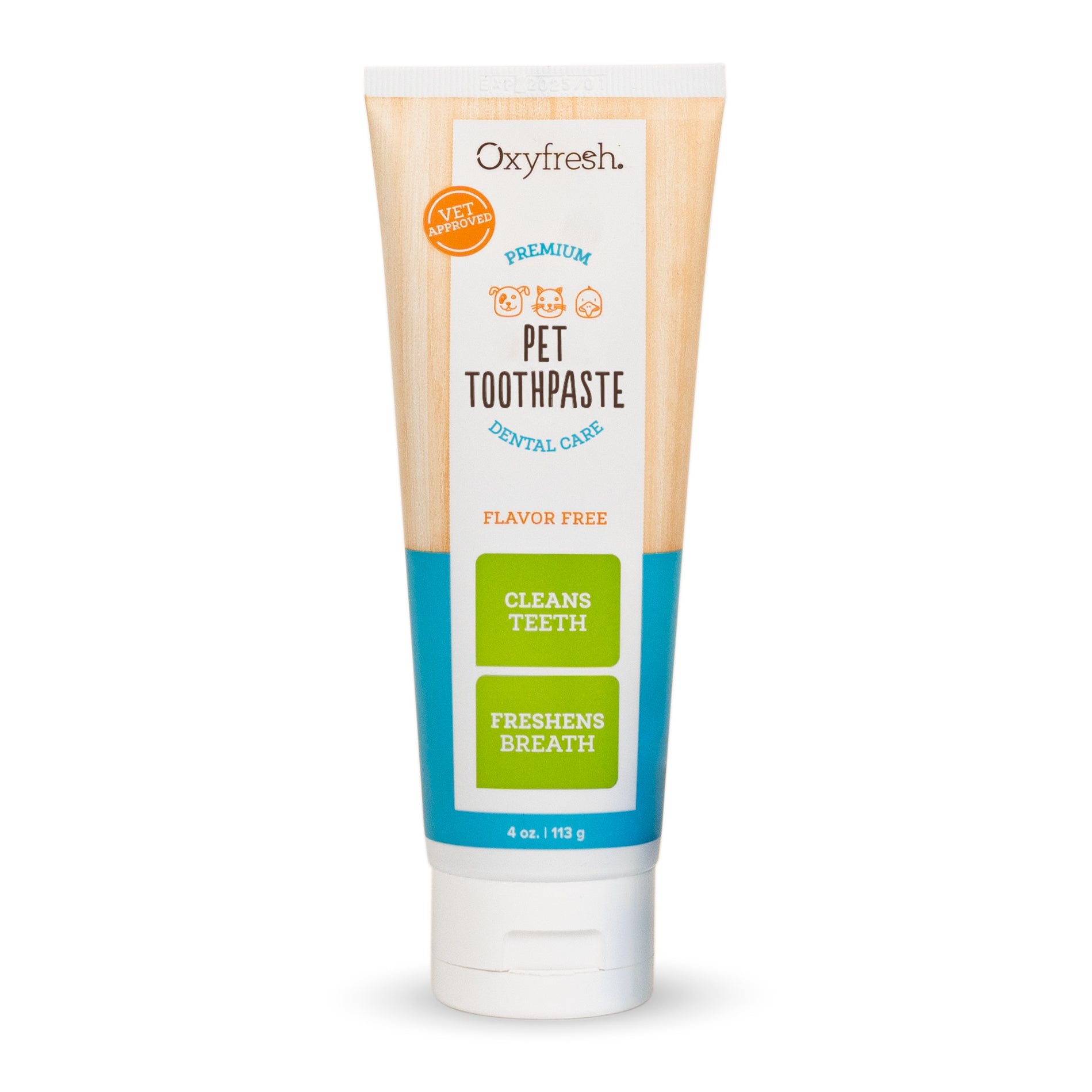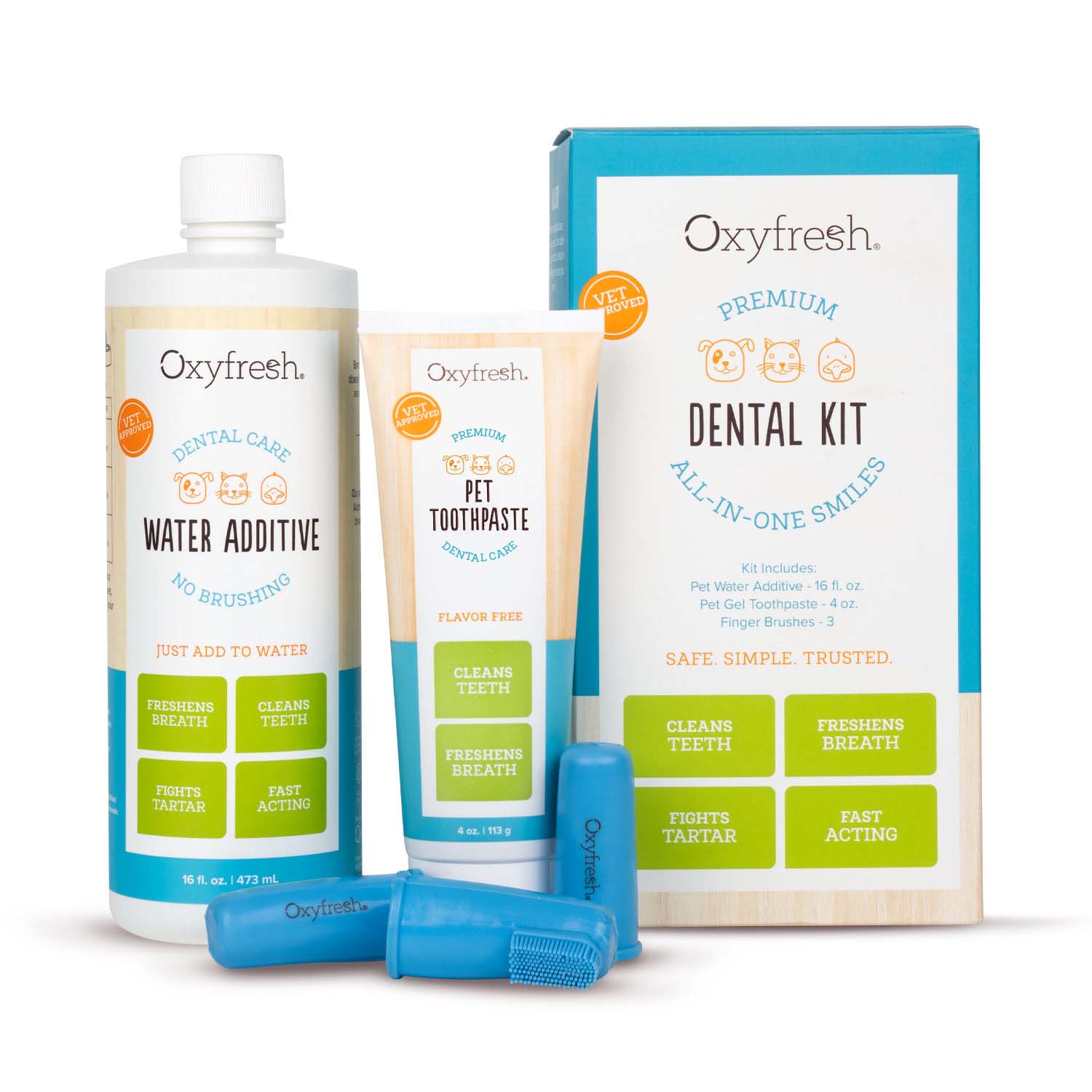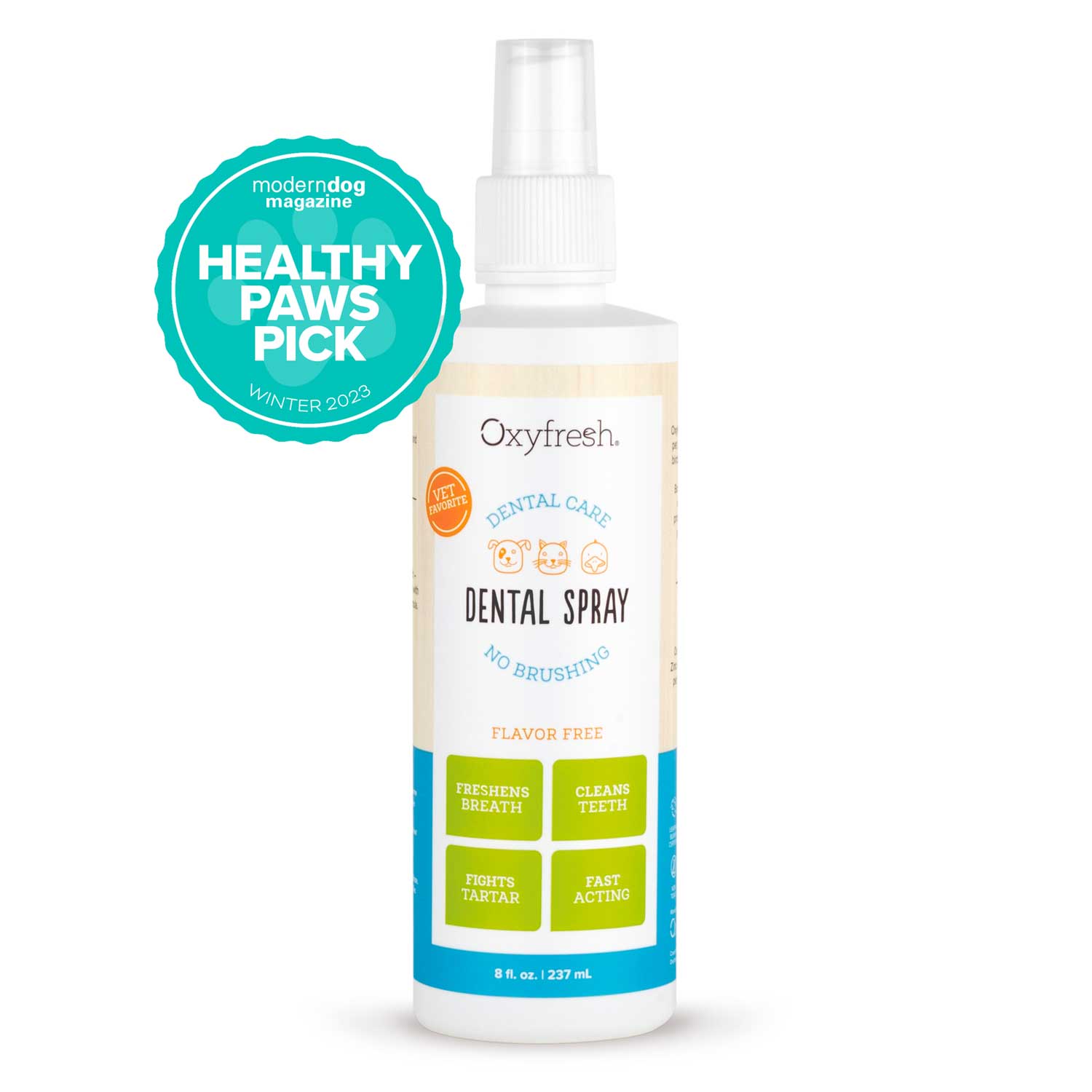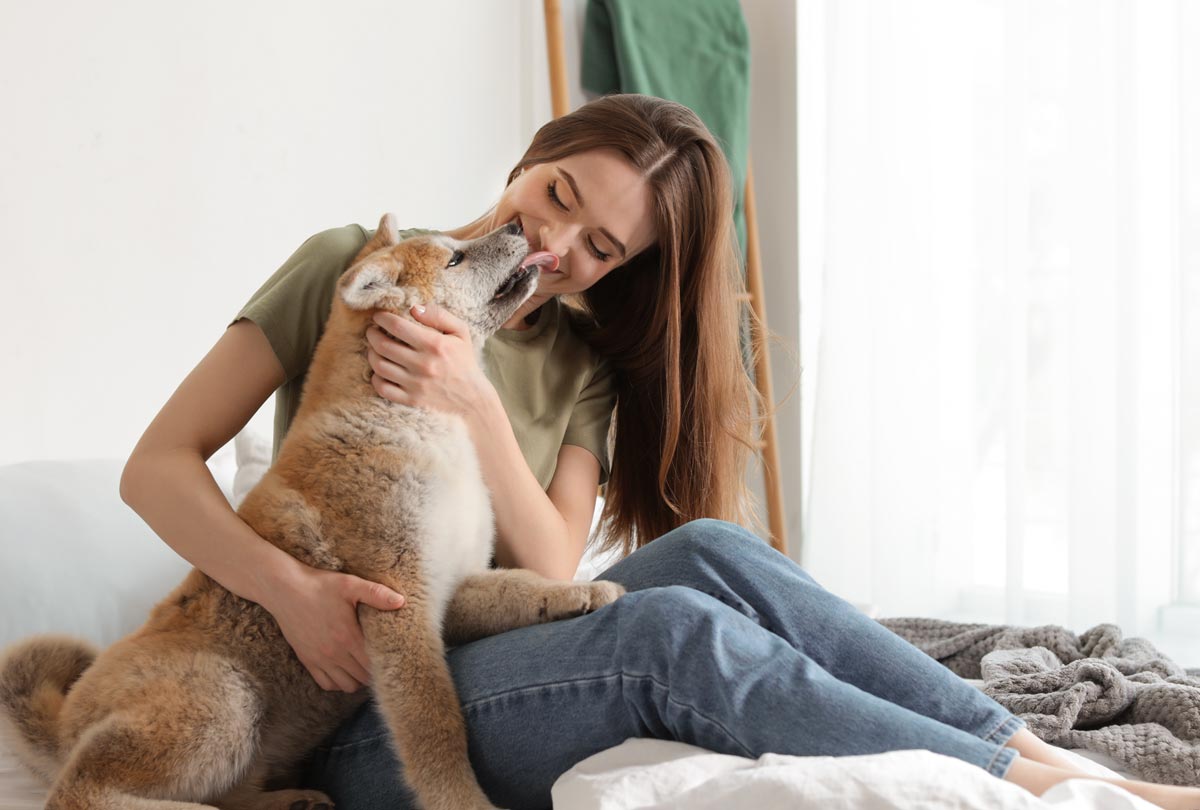While several conditions can cause bad dog breath, poor oral health is the #1 culprit for this smelly situation. The good news is it’s NEVER too late to get your dog’s breath in better shape. And you don’t have to break a sweat to do it.
Is It Normal for Dogs to Have Bad Breath?
From the fishy to the funky, here's the bottom line: any foul-smelling dog breath is NOT normal and requires your attention.
But I thought dogs were supposed to have bad breath!
In the past, it was simply accepted that dogs would have "dog breath."
But the truth is dogs’ oral care needs have NEVER changed; it’s our relationship with our dogs that has. (Our ancestors would be rolling in their graves if they could see us now, posing with our pets in matching sweater vests!)
Today, our dogs are family, and like all family members, they need regular dental care to be their best.
Not only will freshening your dog’s breath improve your bond and stop scorching your nose hairs, but a healthy dog mouth can increase a dog’s lifespan by two to five years.
Causes of Dog Bad Breath
Don’t blow off that stinky dog breath and hope it’ll magically go away on its own ... it won’t. There’s always a reason for the stench. But once you figure out the cause of your dog’s bad breath and adopt an easy solution(s), the only thing you’ll be smelling is the sweet smell of success!
Poor Oral Health
The primary cause of bad breath in dogs is poor oral hygiene. Just like with humans, this starts with plaque buildup. When plaque – a clear, smelly slime of bacteria – forms on a dog’s teeth after meals and stays there, it causes inflammation of the gums. This is gingivitis, the earliest stage of gum disease. Ongoing inflammation weakens the attachment between the gums and soft tissue and bones of the teeth.
As the plaque mineralizes (hardens) into yellow-brown tartar at the crown of the dog’s teeth, harmful bacteria infiltrate BELOW the dog’s gum line, causing even more inflammation and tissue damage. (This is advancing periodontal disease.)
Eventually the gums will begin to detach from the teeth, which is very painful for pets. To protect your dog’s smile, breath, and overall well-being, daily plaque removal is key. (Guys, this is NO joke – plaque starts the process of hardening into tartar in only 24 hours!!)
Gingival Hyperplasia (Gum Overgrowth)
Gingival hyperplasia is a condition where a dog’s gum tissue grows excessively, often covering parts of the teeth. Veterinarians believe this is how certain dogs respond to inflammation in the mouth due to excess bacteria from gum disease. Most dogs’ gums begin to RECEDE when they have poor oral health, but with certain breeds like Boxers, Bulldogs and Cocker Spaniels, their gums will often SWELL. This swelling traps bacteria and food particles, leading to notoriously bad dog breath. But don’t worry – this excess gum tissue can be easily removed during a dental cleaning.
Your Dog Is #1 at Eating #2s (POOP)
We’ll do you a solid and try to hold in our poop jokes ... because if you have a poop eater on your hands, it’s no laughing matter! Pups who eat poop or other gross stuff not only have BAD DOG BREATH, but they also raise their risk of getting a parasite or infection. Poop eating – coprophagy if you like to impress your friends with big words – can be caused by health conditions or behavioral issues. To get to the bottom (sorry) of your dog’s poop eating, check out: Why Does My Dog Eat Poop & How to Fix It.
Object Stuck in Dog’s Teeth or Gums
If your dog is the I’ll-eat-anything type, don’t be surprised if they eat a stick, rock, part of a chew toy, or other unpalatable item. If these objects become lodged between their teeth or stuck in their gum tissue, it can cause an infection, leading to stinky dog breath. Dogs are pros at hiding their pain, so if they have good oral health and the smell comes on suddenly, get them in for an appointment.
Canine Diabetes
Approximately 1 in 300 dogs will get diabetes, with females, overweight pooches, and middle-aged to senior dogs at highest risk. Common signs of diabetes in dogs include increased thirst and urination, unexplained weight loss, lethargy, and vision problems. When diabetes is out of control, ketones can build up in the blood, creating a fruity or acetone-like smell to the dog’s breath. This is serious and warrants a trip to the vet, ASAP.
Kidney Disease
When the kidneys aren’t filtering blood like they should, it can cause urea to build up in the blood, giving the dog’s breath a distinctly bad smell, reminiscent of ammonia, urine or rotting fish. This is a sign of kidney disease, and your dog should be evaluated by their vet.
Liver Problems
A key role of the liver is to filter out toxins, so if your dog’s liver isn’t functioning properly, their breath will take on a very foul odor, often described as musty, sulfurous or like a dead animal. Other signs of liver disease include jaundice (yellowing of the skin, whites of the eyes, gums, or inside of the ears); increased thirst and urination; loss of appetite/weight loss; vomiting and diarrhea; and ascites (buildup of fluid in the abdomen). If you suspect your dog has liver problems, make an appointment with the vet. The liver is renowned for its ability to regenerate and heal, and catching a problem early is best.
Dietary Deficiencies
A gut out of balance will unleash smelly dog breath, not to mention epic dog toots. A bacterial imbalance is often caused by dietary deficiencies or eating too many carbs. (We can relate.) This risk is greater with raw or home-cooked diets. We’re not trying to stir up drama (that’s the cat’s job), but here’s some food for thought: In a nutrition study by UC Davis School of Veterinary Medicine, researchers looked at 200 home-prepared dog nutrition recipes and found that 95% resulted in food that was deficient in at least one essential nutrient, and 83% yielded multiple nutrient deficiencies.
Raw diets also raise the risk of dogs getting salmonella, which can lead to vomiting and watery diarrhea, two things that will NEVER make a dog smell good. Discuss your dog’s diet with the vet, and if they think their gut is out of whack, they may recommend a daily probiotic.
Dog Ate Something Toxic
If your little mischief maker eats a toxic houseplant, medication, or chemical, their breath can suddenly take on a foul smell, often chemical in nature. They’d show other symptoms too, like excessive drooling, GI upset, or muscle tremors. Don’t force your dog to vomit if they eat a toxic substance: instead call the vet immediately. Keep toxins out of paw’s reach and only adorn your digs with dog-friendly plants.
Oral Tumors
More common in older dogs, especially male dogs with heavily pigmented gums, oral tumors often cause bad breath as parts of the tissue die or the mass becomes infected or invades the bone. In addition to dog bad breath, you may notice bloody saliva, increased drooling, or signs of pain like not wanting to be touched around the mouth or difficulty eating.
Yearly exams are key, as veterinarians will be able to spot oral tumors. Surgery is the most common course of treatment. If the vet is concerned about the tumor, it will be sent off for biopsy. This is often done during a full dental cleaning, as the pet is already under anesthesia. Note: If you have a PhD in googling health conditions and freaking out, we get it. But many oral masses are benign (non-cancerous) or treatable, so keep calm and let the vet be your guide.
Tummy Troubles
Because the mouth is the start of the gastrointestinal tract, when there’s trouble in the tummy, it can make your dog’s breath smell bad too, especially if they have acid reflux, where stomach acid comes back up into the esophagus. (Stomach acid = STINKY.) Dogs with acid reflux will often make burping sounds after eating, display weak vomiting, whine while they eat, or only eat a little bit at a time. Fortunately, there are many diet and lifestyle hacks to get your dog on the path to better digestion.
Broken Tooth
If your dog has a broken tooth, often caused by trauma or chewing on too-hard objects like ice cubes, hard plastic toys, or rawhides, it can create an infection or abscess if left untreated. This can give dogs very smelly breath, and more concerning, it’s extremely painful for them.
What Dogs Are Most Prone to Gum Disease & Bad Breath?
(Wiener dog’s photo removed to reduce shame)
Small Dog Breeds
Small dog breeds are at much higher risk for early onset and fast progression of gum disease. In fact, a UK study of more than 22,000 dogs showed that those weighing under 22 lb. were 3x more likely to develop periodontal disease (advanced gum disease) compared to medium- and large-sized dog breeds.
Why are small dogs more likely to have dental issues and therefore bad dog breath? Because of tooth overcrowding. A typical adult dog has forty-two teeth. All those teeth in one itty-bitty mouth creates overcrowding, which allows plaque to easily build up.
Small dog breeds known for bad breath:
- Toy Poodles
- Cavalier King Charles Spaniels
- Lhasa Apsos
- Yorkies
- Maltese
- Pomeranians
- Chihuahuas
- Dachshunds (aka wiener dogs)
Brachycephalic Dog Breeds
Dogs with flat-faces, officially known as brachycephalic dogs (unofficially, as adorable smooshy-faces), often have malocclusions, meaning their teeth don’t line up properly. This, combined with their teeth being close together, can make the task of teeth cleaning more difficult and cause plaque to accumulate.
Brachycephalic breeds prone to bad breath:
- Pugs
- Bulldogs
- Boxers
- Boston Terriers
- Shih Tzus (we shih tzu not)
My dog isn’t on the breath-that-smells-like-$#!t list, so I’m good to go!
Umm ... not so fast. While certain dog breeds may be more predisposed to gum disease, the fact is 90% of dogs over age two have some level of gum disease, which leads to smelly dog breath. All dogs need regular oral care to keep their teeth and gums healthy and their breath fresh.
Treating Your Dog’s Bad Breath
Reality check: If your dog has lots of tartar buildup or advanced gum disease, there is no miracle home cure. You need to make a fresh start with a professional dental cleaning. This is the ONLY WAY to remove all that yellow or brown rock-hard tartar (calculus) and clean under the gum line, which involves using hand instruments and scaler tips while the pet is under anesthesia, and then polishing the teeth. Waiting will only make the dental cleaning more expensive.
A routine dental cleaning will cost around $500 (depending on what part of the country you live in), but the cost will go up if tooth extractions or soft tissue removal is needed, things associated with more severe gum disease. Also, many veterinary clinics require blood work for dogs over seven years old before putting them under anesthesia. That cost is usually around $115. Don’t worry: your vet will give you a quote before any work is done.
Once your dog has their cleaning, you can start fresh with good oral care at home and potentially eliminate or reduce the need for professional cleanings in the future. And your dog’s breath will be so fresh. SUH-WEET!
6 Solutions to Fix Dog Bad Breath
Whether you want to try your hand at dog toothbrushing or you’re more the mellow, hands-off type, we’ve got you covered. There are dog bad breath solutions for everyone.
1. Make Sure Your Dog Gets an Annual Exam
During your dog’s annual exam, the vet will look inside your dog’s mouth to determine if their teeth and gums are healthy and make sure they don’t have any masses in the mouth. Because dog bad breath can sometimes indicate a more serious health condition, catching any problems early is important.
2. Brush Your Pup’s Teeth
Tooth brushing will aways be the best way to freshen dog bad breath and keep plaque and tartar from building up on their teeth and gums. Bacteria from plaque and tartar are the root of bad breath in dogs. A few things to keep in mind:
- Never use human toothpaste on a dog. Ingredients like fluoride, xylitol and artificial sweeteners can make dogs sick.
- A flavor-free dog toothpaste is best for picky pooches. And skip formulas with baking soda – dogs hate the taste, and it can cause stomach upset. Sure, we’re a bit biased, but we recommend Oxyfresh Pet Toothpaste. It’s the only dog toothpaste with Oxygene®, a non-toxic oxidizer that eliminates the bacteria that cause plaque and bad dog breath right at the source. No flavor coverups!
- To keep your dog’s breath fresh, brush at least three times a week and ideally every day.
- If you have a small dog, a finger toothbrush may be a better option than a toothbrush with a handle.
- To become a toothbrushing pro, check out How to Brush Your Dog’s Teeth ... Without Losing Your Sanity.
3. Use Dental Treats or Dental Toys to Freshen Your Dog’s Breath
Dental treats and chew toys are a fun supplement to a regular dog dental routine, but supplement is the key word here. They should not be the ONLY dental care your dog receives.
- Look for dental treats that have the registered seal from the Veterinary Oral Health Council. That means testing has been done to ensure the product works to fight plaque.
- Choose dental chew toys that are made of 100% natural rubber with ridges and grooves to stimulate the gums and clean your dog’s teeth. You can even apply dog toothpaste or coconut oil (a natural plaque fighter) to the toy, and it’ll be like your dog is brushing their own teeth – brilliant!
- Avoid hard plastic or acrylic toys and chews like antlers and hard bones. They can easily fracture your dog’s teeth, especially if their teeth are already in poor shape.
4. Feed Your Dog a Quality Diet to Fight Bad Breath
Giving your dog high-quality, well-balanced nutrition can help manage many of the causes of bad breath on the list. And be sure to buy appropriate-size kibble for your dog so they aren’t swallowing it whole. You can also talk to your vet about putting your dog on a dental diet. These foods often have plaque-fighting ingredients and feature larger pieces to create a scraping action that helps remove plaque.
5. Hydrate Your Dog’s Way to Fresher Breath
Adequate hydration is key in preventing dog bad breath. Water flushes out a dog’s mouth, whether they’ve just eaten a smelly bowl of kibble or licked their backside. Water also helps flush out toxins from the dog’s body, which is important for liver and kidney health.
How much water should a dog drink each day? While there are many factors to consider, such as age and activity level, on average, you should aim for one ounce (1/8 cup) of water per pound of body weight.
Pro tip: If you struggle with getting your dog to drink enough water, try a pet water fountain.
6. Make a Splash with a Dog Water Additive
This is the best-kept secret to fresh dog breath: adding a dental water additive into your dog’s water bowl or fountain. With every drink, your dog will get essential protection against the bacteria that cause plaque and bad dog breath.
Pro tip: Make sure it’s an UNFLAVORED water additive, otherwise your dog may not drink their water, which would be bad news for their breath.
Introducing Oxyfresh Dental Water Additive: Easiest Trick to Maintain Fresh Dog Breath
Oxyfresh Dental Water Additive is the ultimate solution if you don’t have the time or energy to brush your dog’s teeth. (Or maybe you have the desire, but your dog is SO not having it!)
This best-selling water additive delivers similar plaque- and bad-breath-fighting benefits as toothbrushing but without all the drama. Simply add a capful to your dog’s water bowl daily and call it good!
USA-made, Oxyfresh Dental Water Additive for dogs (cats too!) is the ONLY ONE on the market with the groundbreaking ingredient Oxygene®, a proprietary breath-freshener that’s 100% safe, non-toxic and PROVEN to benefit oral health.
Unlike dog water additives that try to MASK dog bad breath with mint and other flavory nonsense, Oxygene® neutralizes stinky dog breath right at the microbial source using the power of oxidation. (If you slept like a dog in science class, oxidation is the process of breaking bonds – in this case, odor bonds.)
At the same time, it targets the bacteria that cause plaque, making it an easy daily strategy to defend against canine gum disease.
The Ultimutt Dog Water Additive for Bad Breath
- Bye-bye, dog bad breath: Oxygene® eliminates smelly bacteria right at the source. No flavor coverups!
- Fights plaque: Halts the formation of plaque and defends against gum disease with every drink.
- Easiest routine ever: Add to your dog’s water bowl and you’re good to go!
- Flavor free: No mint, clove, green tea, or other flavors, so weirdo dogs won’t mind the taste.
- No brushing: Because the only fingers your dog wants in their mouth are chicken fingers.
Seriously, why fuss with the brush? Oxyfresh Dental Water Additive for dogs is the EASIEST way to get rid of dog bad breath, keep their teeth clean, and help prevent gum disease. Order today and your dog will thank you ... with a fresh kiss, of course!











